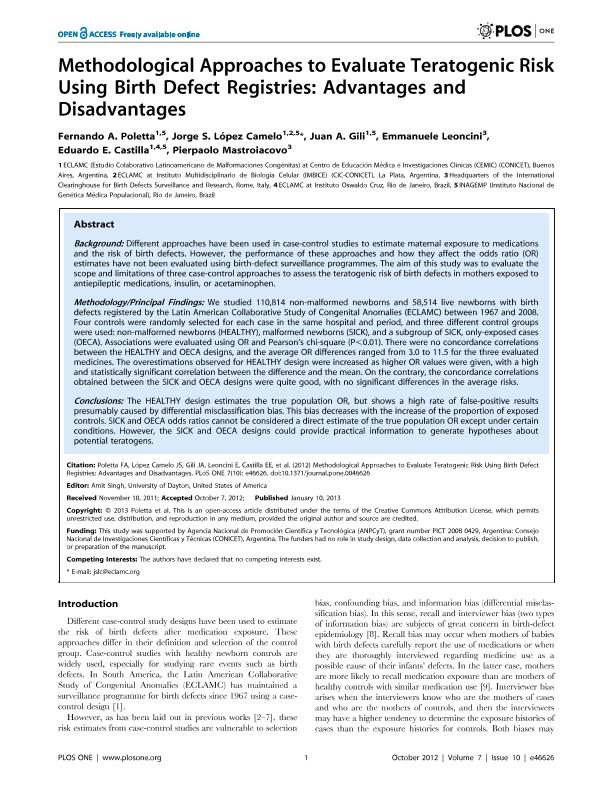Artículo
Methodological Approaches to Evaluate Teratogenic Risk Using Birth Defect Registries: Advantages and Disadvantages
Poletta, Fernando Adrián ; López Camelo, Jorge Santiago
; López Camelo, Jorge Santiago ; Gili, Juan Antonio
; Gili, Juan Antonio ; Leoncini, Emmanuele; Castilla, Eduardo Enrique
; Leoncini, Emmanuele; Castilla, Eduardo Enrique ; Mastroiacovo, Pierpaolo
; Mastroiacovo, Pierpaolo
 ; López Camelo, Jorge Santiago
; López Camelo, Jorge Santiago ; Gili, Juan Antonio
; Gili, Juan Antonio ; Leoncini, Emmanuele; Castilla, Eduardo Enrique
; Leoncini, Emmanuele; Castilla, Eduardo Enrique ; Mastroiacovo, Pierpaolo
; Mastroiacovo, Pierpaolo
Fecha de publicación:
10/2012
Editorial:
Public Library of Science
Revista:
Plos One
ISSN:
1932-6203
Idioma:
Inglés
Tipo de recurso:
Artículo publicado
Clasificación temática:
Resumen
Background: Different approaches have been used in case-control studies to estimate maternal exposure to medications and the risk of birth defects. However, the performance of these approaches and how they affect the odds ratio (OR) estimates have not been evaluated using birth-defect surveillance programmes. The aim of this study was to evaluate the scope and limitations of three case-control approaches to assess the teratogenic risk of birth defects in mothers exposed to antiepileptic medications, insulin, or acetaminophen. Methodology/Principal Findings: We studied 110,814 non-malformed newborns and 58,514 live newborns with birth defects registered by the Latin American Collaborative Study of Congenital Anomalies (ECLAMC) between 1967 and 2008. Four controls were randomly selected for each case in the same hospital and period, and three different control groups were used: non-malformed newborns (HEALTHY), malformed newborns (SICK), and a subgroup of SICK, only-exposed cases (OECA). Associations were evaluated using OR and Pearson's chi-square (P<0.01). There were no concordance correlations between the HEALTHY and OECA designs, and the average OR differences ranged from 3.0 to 11.5 for the three evaluated medicines. The overestimations observed for HEALTHY design were increased as higher OR values were given, with a high and statistically significant correlation between the difference and the mean. On the contrary, the concordance correlations obtained between the SICK and OECA designs were quite good, with no significant differences in the average risks. Conclusions: The HEALTHY design estimates the true population OR, but shows a high rate of false-positive results presumably caused by differential misclassification bias. This bias decreases with the increase of the proportion of exposed controls. SICK and OECA odds ratios cannot be considered a direct estimate of the true population OR except under certain conditions. However, the SICK and OECA designs could provide practical information to generate hypotheses about potential teratogens.
Palabras clave:
Teratogenic Risk
,
Birth Defect
Archivos asociados
Licencia
Identificadores
Colecciones
Articulos(IMBICE)
Articulos de INST.MULTIDISCIPL.DE BIOLOGIA CELULAR (I)
Articulos de INST.MULTIDISCIPL.DE BIOLOGIA CELULAR (I)
Articulos(SEDE CENTRAL)
Articulos de SEDE CENTRAL
Articulos de SEDE CENTRAL
Citación
Poletta, Fernando Adrián; López Camelo, Jorge Santiago; Gili, Juan Antonio; Leoncini, Emmanuele; Castilla, Eduardo Enrique; et al.; Methodological Approaches to Evaluate Teratogenic Risk Using Birth Defect Registries: Advantages and Disadvantages; Public Library of Science; Plos One; 7; 10; 10-2012; 1-11; e46626
Compartir
Altmétricas



